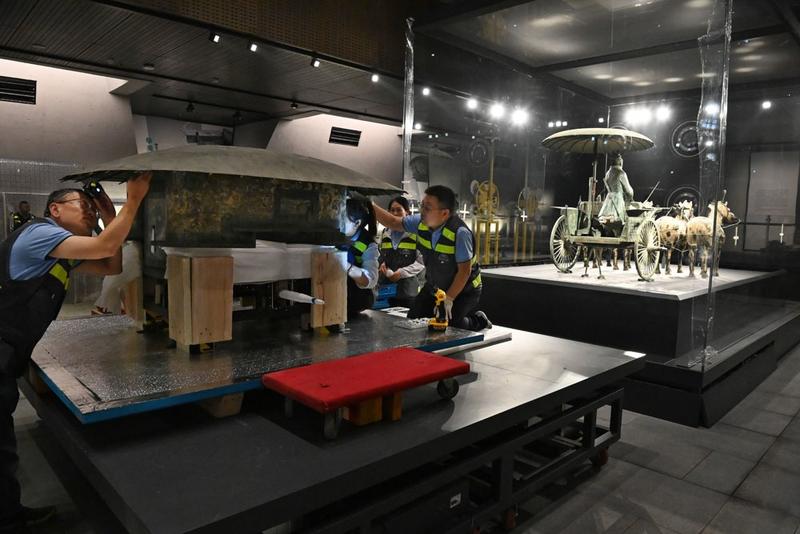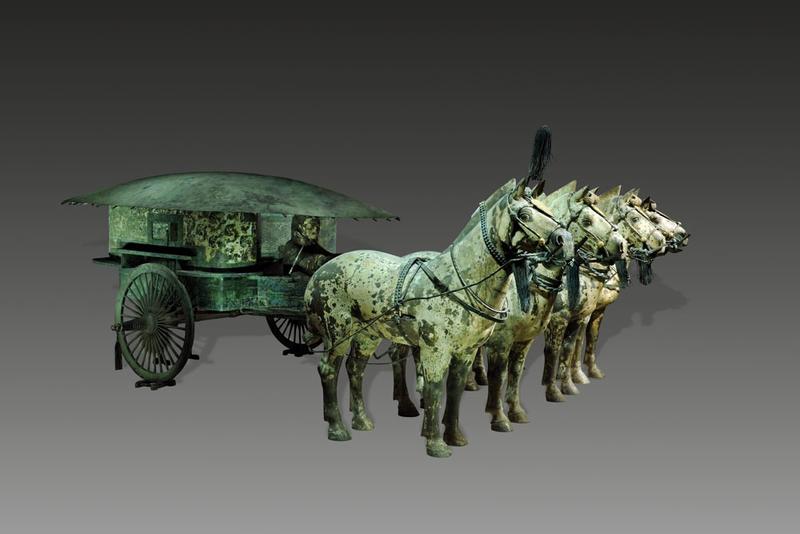 A restored bronze chariot is assembled at a newly built museum in Xi'an, Shaanxi province, on May 12, 2021. (ZHANG TIANZHU / FOR CHINA DAILY)
A restored bronze chariot is assembled at a newly built museum in Xi'an, Shaanxi province, on May 12, 2021. (ZHANG TIANZHU / FOR CHINA DAILY)
If China's first emperor, Qinshihuang of the Qin Dynasty (221-206 BC), were still alive, he might notice that some elements of his underground army have left their Terracotta Warrior comrades this week.
A newly built museum designed to exhibit the bronze chariots and horses excavated from the emperor's mausoleum will open to the public in Xi'an, Shaanxi province, on May 18. The artifacts had been moved there by Wednesday.
Among China's archaeological findings, the Qin bronze chariots were the earliest, largest and best-preserved objects of their kind ever discovered, and they are of great value for research into the smelting techniques, bronze manufacturing technology and vehicle structure during the Qin Dynasty.
Wu Yongqi, Former curator of Emperor Qinshihuang's Mausoleum Site Museum
The idea is to highlight the objects' historical value and enable tourists to more easily and clearly understand the period. Previously, the chariots and horses were exhibited in a showroom of the Emperor Qinshihuang's Mausoleum Site Museum and not far from the renowned Terracotta Warriors, where tourist traffic was heavy. The new museum is expected to ease congestion.
ALSO READ: Snapshots of the Qin era
During this year's May Day holiday, the mausoleum site museum received 299,342 visits.
The new museum is just 240 meters from the chariot excavation site, which helps give visitors a firsthand experience at an archaeological dig.
For the move to the new museum, the Qin bronze chariots and horses were disassembled into some 100 parts or assemblies, packaged in soft padding and then sealed in dozens of boxes.
"Each set of relics had been packed tightly in boxes and will be unpacked at the new museum," said Dang Shixue, a researcher who focuses on the chariots and horses at the site museum.
As with the Terracotta Warriors, the bronze chariots and horses are burial objects and are widely believed to resemble the real imperial chariots and horses used by Qinshihuang.
Two sets of chariots and horses were unearthed in December 1980 by an archaeological team from the Emperor Qinshihuang's Mausoleum Site Museum. Each is about half the size of a real one. They were found in broken pieces, and experts at the museum spent about eight years restoring them.
 Researcher Wu Yongqi (left) checks on a bronze horse before it is installed at its new home. (ZHANG TIANZHU / FOR CHINA DAILY)
Researcher Wu Yongqi (left) checks on a bronze horse before it is installed at its new home. (ZHANG TIANZHU / FOR CHINA DAILY)
Wu Yongqi, former curator of the site museum, said the chariot components and bronze horses were basically complete at the time they were discovered because the tomb had not been robbed.
"Among China's archaeological findings, the Qin bronze chariots were the earliest, largest and best-preserved objects of their kind ever discovered, and they are of great value for research into the smelting techniques, bronze manufacturing technology and vehicle structure during the Qin Dynasty," he said.
Dang said chemical analysis of the chariots indicated that the process during the Qin Dynasty was no better than that of the Warring States Period (475-221 BC).
READ MORE: Rediscovering China's early civilization
"But in terms of manufacturing and casting, the skills used to produce the bronze chariots were very advanced and complex," Dang said. "This was not only because there were many parts, but because the overall structure of a bronze chariot is twisting and rotating."
Many parts on a chariot required multiple stages of casting to build up welds. Binding with leather straps also shows exquisite workmanship in connecting various components of the vehicle, he said.
As for the bronze horses, Dang said, researchers reckoned the four legs were cast first and the mold for a horse's body was created later. Then the legs were joined to the body.
 Original look of a bronze chariot from the Qin Dynasty.
Original look of a bronze chariot from the Qin Dynasty.
"The two sets of bronze chariots have more than 3,000 components," Dang said. "The production process is extremely complex and detailed. The bronze itself provides rich information as we delve into the research work."
"The new museum is about 240 meters from the excavation site of the two sets of bronze chariots and horses, which will make it convenient for tourists to see the ruins and give them a sense of having an on-site experience," said Li Gang, director of the Emperor Qinshihuang's Mausoleum Site Museum.
ALSO READ: Unearthing a fascinating past
To better preserve and exhibit the bronze pieces in the new museum, Li said, the display cabinets are sealed and have constant temperature and humidity control.
Construction of the new museum began in late December 2017.On International Museum Day, which falls on May 18, it will open to the public for a trial run. The price of tickets will be included in the package of the mausoleum site museum, with no additional fees charged. Free shuttle buses to ferry tourists from the gate to the new site will also be provided.
The museum is on the southwest side of Qinshihuang's mausoleum and occupies about 8,000 square meters.


